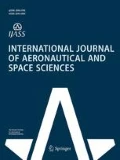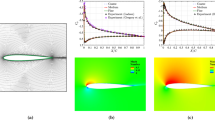Abstract
The RANS equations are widely used to analyze complex flows over aircraft. The equations require a turbulence model for turbulent flow analyses. A suitable turbulence must be selected for accurate predictions of aircraft aerodynamic characteristics. In this study, numerical analyses of three-dimensional aircraft are performed to compare the results of various turbulence models for the prediction of aircraft aerodynamic characteristics. A 3-D RANS solver, MSAPv, is used for the aerodynamic analysis. The four turbulence models compared are the Sparlart–Allmaras (SA) model, Coakley’s \(q-\omega \) model, Huang and Coakley’s \(k-\varepsilon \) model, and Menter’s \(k-\omega \) SST model. Four aircrafts are considered: an ARA-M100, DLR-F6 wing–body, DLR-F6 wing–body–nacelle–pylon from the second drag prediction workshop, and a high wing aircraft with nacelles. The CFD results are compared with experimental data and other published computational results. The details of separation patterns, shock positions, and \(C_{p}\) distributions are discussed to find the characteristics of the turbulence models.


















Similar content being viewed by others
Abbreviations
- u :
-
Velocity component in the x direction
- v :
-
Velocity component in the y direction
- w :
-
Velocity component in the z direction
- \(\rho \) :
-
Density
- p :
-
Pressure
- \(C_{L}\) :
-
Lift coefficient
- \(C_{D}\) :
-
Drag coefficient
- \(\hbox {Re}\) :
-
Reynolds number
- \(\alpha \) :
-
Angle of attack
- \(\eta \) :
-
Normalized span location
- k :
-
Turbulent kinetic energy
- q :
-
Turbulent velocity scale
- \(\omega \) :
-
Specific dissipation rate
References
Kral LD (1998) Recent experience with different turbulence models applied to the calculation of flow over aircraft components. Prog Aerosp Sci 34:481–541
Marconi F, Siclari M, Carpenter R (1994) Comparison of TLNS3D computations with test data for a transport wing/simple body configuration, AIAA paper 94-2237
Kwak E, Lee N, Lee S, Park S (2012) Performance evaluation of two-equation turbulence models for 3D wing-body configuration. Int J Aeronaut Space Sci 13(3):307–316
https://aiaa-dpw.larc.nasa.gov/. Accessed 1 Mar 2018
Lee S, Choi D (2006) On coupling the reynolds-averaged Navier–Stokes equations with two-equation turbulence model equations. Int J Numer Methods Fluids 50(2):165–197
Spalart PR, Allmaras SR (1992) A one-equation turbulence model for aerodynamic flows, AIAA Paper 92-0439
Coakley TJ (1983) Turbulence modeling methods for the compressible Navier–Stokes equations, AIAA Paper 83-1693
Huang PG, Coakley TJ (1992) An implicit Navier–Stokes code for turbulent flow modeling, AIAA Paper 92-0547
Menter FR (1994) Two-equation Eddy-viscosity turbulence models for engineering applications. AIAA J 32(8):1598–1605
Roe PL (1981) Approximate Riemann solvers, parameter vectors, and difference schemes. J Comput Phys 43(2):357–372
Van Leer B (1974) Towards the ultimate conservative difference scheme. II. Monotonicity and conservation combined in a second-order scheme. J Comput Phys 14(4):361–370
http://cfl3d.larc.nasa.gov/. Accessed 1 Mar 2018
Carr MP, Pallister KC (1984) Pressure distributions measured on research wing M100 mounted on an axisymmetric body, AGARD AR-138 addendum
Tinoco E, Su T (2004) Drag prediction with the Zeus/CFL3D system, AIAA Paper 2004-0552
Park Y (2012) CFD and wind tunnel results of WTET configuration, KARI-CADT-ELN-2012-002
Epstein B, Rubin T, Séror S (2002) An accurate multiblock ENO driven Navier–Stokes solver for complex aerodynamic configurations, ICAS 2002 Congress
Acknowledgements
This work was supported by Korea Aerospace Research Institute (KARI) and Inha University.
Author information
Authors and Affiliations
Corresponding author
Additional information
An earlier version of this paper was presented at APISAT 2017, Seoul, Korea, October 2017.
Rights and permissions
About this article
Cite this article
Jang, Y., Huh, J., Lee, N. et al. Comparative Study on the Prediction of Aerodynamic Characteristics of Aircraft with Turbulence Models. JASS 19, 13–23 (2018). https://doi.org/10.1007/s42405-018-0022-6
Received:
Revised:
Accepted:
Published:
Issue Date:
DOI: https://doi.org/10.1007/s42405-018-0022-6




